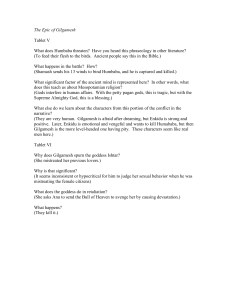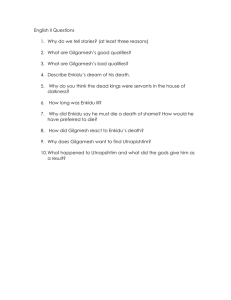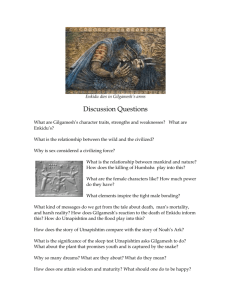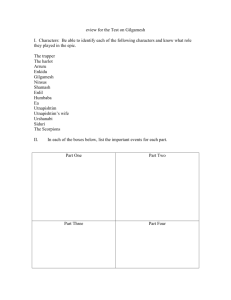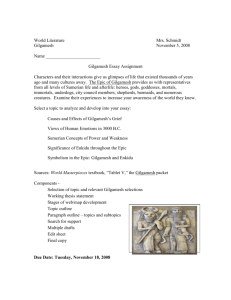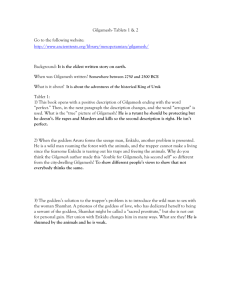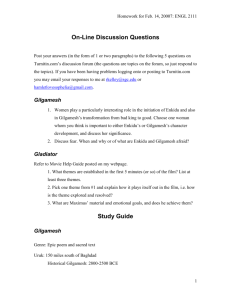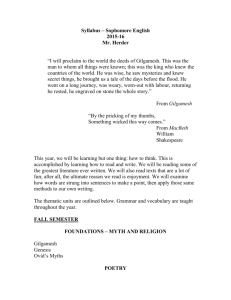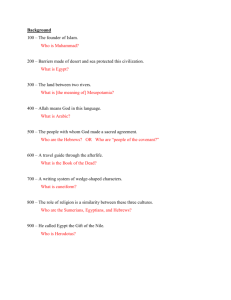Reading Guide: The Epic of Gilgamesh
advertisement
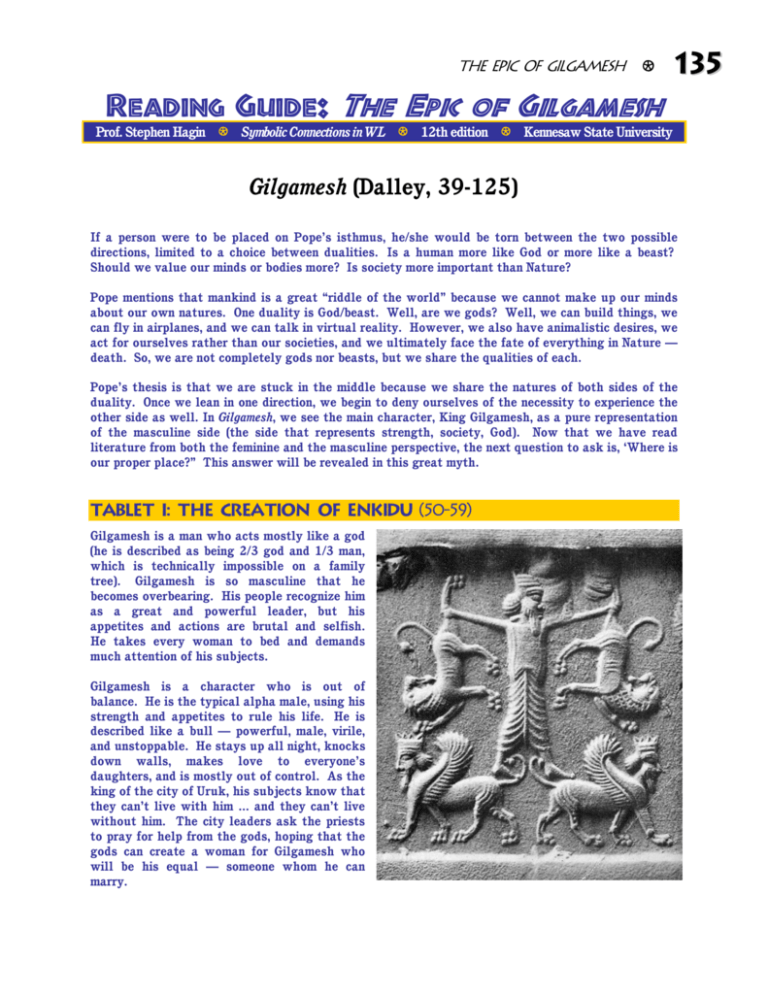
The Epic of Gilgamesh K 135 Reading Guide: The Epic of Gilgamesh Prof. Stephen Hagin K Symbolic Connections in WL K 12th edition K Kennesaw State University Gilgamesh (Dalley, 39-125) If a person were to be placed on Pope’s isthmus, he/she would be torn between the two possible directions, limited to a choice between dualities. Is a human more like God or more like a beast? Should we value our minds or bodies more? Is society more important than Nature? Pope mentions that mankind is a great “riddle of the world” because we cannot make up our minds about our own natures. One duality is God/beast. Well, are we gods? Well, we can build things, we can fly in airplanes, and we can talk in virtual reality. However, we also have animalistic desires, we act for ourselves rather than our societies, and we ultimately face the fate of everything in Nature — death. So, we are not completely gods nor beasts, but we share the qualities of each. Pope’s thesis is that we are stuck in the middle because we share the natures of both sides of the duality. Once we lean in one direction, we begin to deny ourselves of the necessity to experience the other side as well. In Gilgamesh, we see the main character, King Gilgamesh, as a pure representation of the masculine side (the side that represents strength, society, God). Now that we have read literature from both the feminine and the masculine perspective, the next question to ask is, ‘Where is our proper place?” This answer will be revealed in this great myth. Tablet I: The Creation of Enkidu (50-59) Gilgamesh is a man who acts mostly like a god (he is described as being 2/3 god and 1/3 man, which is technically impossible on a family tree). Gilgamesh is so masculine that he becomes overbearing. His people recognize him as a great and powerful leader, but his appetites and actions are brutal and selfish. He takes every woman to bed and demands much attention of his subjects. Gilgamesh is a character who is out of balance. He is the typical alpha male, using his strength and appetites to rule his life. He is described like a bull — powerful, male, virile, and unstoppable. He stays up all night, knocks down walls, makes love to everyone’s daughters, and is mostly out of control. As the king of the city of Uruk, his subjects know that they can’t live with him ... and they can’t live without him. The city leaders ask the priests to pray for help from the gods, hoping that the gods can create a woman for Gilgamesh who will be his equal — someone whom he can marry. 136 K UNIT 2 Relief comes in the form of a newly created entity: Enkidu. He was created much like Adam (or sometimes Eve) in the Genesis story — from the clay of the earth (plus water and a Divine Will by Aruru, a creator goddess whom we have seen before as the goddess Ninhursag). At first Enkidu is an unpolished person, an incomplete, undeveloped character. He is described as an animal (hairy and wild), and he protects these animals from humans. Since this doesn’t serve the people well, Enkidu is viewed as a force of destruction and chaos (much like the serpent in Eden). Once Enkidu is created, he protects the animals. One day, a hunter (trapper) examines his traps, only to find that someone has been releasing the animals that he had caught. As the days pass by, the hunter grows more frustrated, and he asks the elders of Uruk and the gods for some relief. The culprit is Enkidu, our nature boy, who has been protecting the animals in every way possible. In fact, he is called “murderous” on page 55, although no references are made to Enkidu killing anything. Now think back to this isthmus motif. Imagine, from left to right, looking at two bodies of land connected in the middle by a narrow strand. Identify one side with the masculine features and the other with the feminine. Enkidu is created to give Gilgamesh some balance, and so we can place Gilgamesh and Enkidu on opposite sides of the isthmus: Gilgamesh in the male (that reflects society) and Enkidu on the feminine side (that reflects nature). The intention of creating a mirror image of Gilgamesh is to help Gilgamesh wander further over to the feminine side, with the best case scenario being a meeting in the middle between both characters. MASCULINE FEMININE “God” “beast” “to act” “to rest” “mind” “body” Society Nature Gilgamesh Enkidu The elders of Uruk send a special intermediary, a priestess, who is known as a “divine harlot.” Her name is Shamhat, and she is the sacred prostitute that will change Enkidu into a man. Much like Adam and Eve, Enkidu learns what nakedness means, and he willingly throws himself on Shamhat. For the next 7 days, Enkidu becomes “cultured” by this woman, whose special spiritual powers from Ishtar allow her to reform Enkidu into a more refined human being. MASCULINE FEMININE Society Nature Gilgamesh Shamhat Enkidu Once the week of rebirth is over, however, all the animals of the forest run and hide from Enkidu. Although he physically looks the same, nature knows that his inner nature has changed. He has changed teams, so to speak, and Enkidu now casts his lot with society rather than nature. Do not be disturbed by the character Shamhat in the story. The ancient cultures often had sacred priestesses who advised the kings and queens about spiritual matters. If a young man displayed too much ignorance, or if the need arose where boys needed to quickly become men (such as in times of war), the king would often offer his sacred harlot to “culture” these young men. The Epic of Gilgamesh K 137 Being a woman, the priestess would have an understanding of the sacred knowledge of life, since woman is more closely connected to the earth and the wisdom of the feminine forces of nature. When the young man would conjugate his relationship with this priestess, he would be said to have “known” her, gaining wisdom of manhood in the process. This is where the word “know” originated (“know” is the Biblical word for “sex”). The ancients saw a connection between wisdom and woman, and woman with growth and development. Gaining knowledge, however, always comes with a price. Once Enkidu has transformed himself into a man from beast, he is rejected by nature (the animals) and must leave that Eden behind him by joining with other people (Gilgamesh). Enkidu, however, is considered to have “diminished” (or, from the the N. K. Sandars version prose version, “grown weak, for wisdom was within him”). Whereas most of us have been taught that the attainment of wisdom makes us stronger, Enkidu sees this differently. Enkidu realizes his weaknesses once he accepts his invitation into the world of dualities. Gaining knowledge, then experience, we can attain wisdom, which is the combination of these two qualities. We become different people, and, in this scene, Enkidu becomes “twice born.” We become more responsible ... and more afraid. However, we will see soon that Enkidu is summoned to the masculine side after his conversion into “[profound] Enkidu” by Shamhat, but Gilgamesh will not be affected at all. He will remain in the camp of the masculine, and this will be the main problem that he must overcome throughout the story – understanding the other side (nature, death, femininity, etc.). The arrival of Enkidu is portended in two dreams that Gilgamesh has. One shows a falling star that lands in Uruk, but Gilgamesh cannot lift it. His mother Ninsun (Gilgamesh’s divine mother, the goddess of wisdom, in the form of a sacred cow) interprets his dream to mean that a companion will soon arrive to become Gilgamesh’s shadow and mirror image. Gilgamesh has another dream where a copper axe falls into his lap. Again, Ninsun explains that the axe is Enkidu. Since an axe is a tool used to cut down trees, Gilgamesh understands that he will be able to cut down pine trees with the help of Enkidu so that he can build a large wooden fortress around his city. Questions for The Epic of Gilgamesh (Tablet I) 1. How is Gilgamesh’s city of Uruk divided? 2. What are some of Gilgamesh’s legendary feats of strength? 3. How can Gilgamesh be two-thirds god and one-third mortal? 4. Why is Gilgamesh constantly referred to as a bull? 5. What complaints do the people of Uruk have about their king? 6. What do the people ask the creation goddess Aruru to do that will bring peace? 7. Describe the physique of the “primitive man,” Enkidu. 8. How does the hunter react when he first encounters Enkidu? 138 K UNIT 2 9. Why does Gilgamesh suggest sending a sacred temple prostitute, Shamhat, to meet Enkidu? 10. Shamhat, the sacred prostitute, is sent to “lie with” Enkidu and to “teach him.” For “six days and seven nights,” what does Enkidu learn? 11. How do the animals treat the newly transformed Enkidu? 12. Why does Shamhat tell Enkidu that he has become “like a god”? 13. What does Enkidu want to do to Gilgamesh before Shamhat convinces him otherwise? 14. What do Gilgamesh’s two dreams signify? 15. Why does Ninsun tell Gilgamesh that he will love Enkidu “as a wife”? 16. Why is Ninsun an appropriate character to interpret Gilgamesh’s dreams? Tablet II: The Challenge (59-63) If you have read this story before, you may have read it in the popular prose version by translator N. K. Sandars. This prose version uses some different tablets than the Dalley version, which is far more authentic and updated (although harder to read). In Dalley’s version, Ishhara, goddess of marriage and childbirth, is being prepared to marry Gilgamesh to provide a balance in his life. In the Sandars version, the people of Uruk attempt to marry him to the Goddess of Love (Ishtar). Enkidu arrives in Uruk to compete with Gilgamesh. At the moment when Gilgamesh is about to enter the house of his bride’s father, Enkidu arrives and blocks Gilgamesh from entering the door. They wrestle, but in the process they discover that each man complements the other, thus making them “whole.” Do not look at this too literally. Metaphorically, each of their characteristics helps to place the other’s traits into a better and healthier balance. Notice that Gilgamesh and Enkidu form a complete person by unifying their dual natures — Enkidu represents nature (feminine force) while Gilgamesh represents civilization (male force). Enkidu becomes the yin to Gilgamesh’s yang. Interestingly, after the fight is over, Enkidu breaks down crying. He begins talking about a creature named Humbaba, the keeper of the Pine Forest of Lebanon. The Epic of Gilgamesh K 139 Rumor tells the people of Uruk that this beast is the “terror of people” whose “breath is death.” Again, what you don’t understand might seem to be scary. Certainly, no one has been able to defeat Humbaba, and no one has challenged this creature and lived to tell about it. Although this inspires Gilgamesh to give it a try, Enkidu’s reaction is to cry. Why? Besides suffering with emotion for failing to defeat Gilgamesh, Enkidu is now viewing the world through a very different filter than he did before. Earlier, as a fully vetted member of Nature, Enkidu cohabited with all the creatures of the wild, including the scary ones, such as lions, bulls, etc. Suddenly, now that he has shifted his bias toward society and away from Nature, he is starting to confront the same fears as the people of Uruk do — the fear of the unknown, or the fear of that which is different from the self. Now that Enkidu is a “man,” he has learned to fear Nature, since Nature is more powerful than himself. Gilgamesh, however, gets this great idea to leave a legacy, and he will do so by building a wall around Uruk. Since there is no hardwood in the Tigris River valley, due to deforestation and competition for resources, our two heroes must travel on a dangerous journey to Lebanon to acquire the wood from the pine forest (the Sandars translation refers to the “cedar” forest, but Dalley explains in a footnote that new discoveries reveal that the wood from many archaeological digs is pine, not cedar). The problem exists in the character of Humbaba, the keeper of the forest, and a monster with the giant tusk, described by Gilgamesh as “evil.” NOTE: When you reach the bottom of page 60, flip to page 141 and read an alternate description of the wrestling match between Gilgamesh and Enkidu. This text comes from an Old Babylonian version of the epic, and it supplies additional scenes that embellish the plot. Questions for The Epic of Gilgamesh (Tablet II) 17. How do the townspeople of Uruk react when they first see Enkidu in the streets? 18. How does Enkidu challenge Gilgamesh? 19. What prompts Enkidu to suddenly collapse and cry? 20. Why is Humbaba protected by Ellil? 21. Describe Humbaba. 22. What does Gilgamesh declare as his new quest? 23. What is Enkidu’s advice to the elders about Gilgamesh’s new mission? Tablet III: Follow the Leader (63-66) Although everyone counsels Gilgamesh against this journey, he rationalizes it as a “win/win” situation — if he successfully returns with the lumber, then he is a hero; if he dies while fighting, then he still becomes a hero and leaves a memorable legacy as a brave warrior. On page 141 of The Power of Myth, Campbell informs us that some people need a war to feel truly alive. In fact, many of us press our limits and participate in risky behaviors because these things make us feel alive, while 1 40 K UNIT 2 ironically placing us close to the hands of death. Those of us who like driving too fast, jumping out of airplanes, or riding roller coasters are acting a lot like Gilgamesh did. Enkidu is adopted by Ninsun, Gilgamesh’s mother, who asks Enkidu to look out for her son. Now that these characters are “brothers,” they should help each other to stay out of trouble. Enkidu, however, instructs the elders to dissuade Gilgamesh from taking this trip on page 63, calling it a journey “not to be undertaken.” Gilgamesh, however, asks his mom, Ninsun, for advice, and she laments to Shamash (the sun god) that her son has a restless heart. Ninsun, Shamash, and the city elders instruct Enkidu to be the leader on the journey, to guide Gilgamesh into the forest, and to bring him back alive. After all, Enkidu knows the paths and the dangers of the forest, so he should lead Gilgamesh. NOTE: When you reach the bottom of page 66, flip to pages 146-147 to read an additional scene showing the elders of Uruk blessing the travelers before they depart and instructing them on how to win the “impossible challenge.” Questions for The Epic of Gilgamesh (Tablet III) 24. Why do the elders in Uruk instruct Enkidu to lead the way into the Pine Forest? 25. Why does Gilgamesh run his idea for adventure past his mother, Ninsun? 26. What character trait in Gilgamesh does Ninsun lament about to Shamash? 27. What is Shamash’s decision? How does he justify it? Tablet IV: The Journey to Lebanon (67-71) Tablet IV begins with a description of the travelers riding upstream to Lebanon. The trip takes from “the new moon to the full moon,” implying a 14-15-day journey, plus 3 additional days (for a total of 1718 travel days). The changes in the moon are symbolic. The full moon would have signified the height of danger and evil, since the moon represents the dark side of life. A new moon (invisible to the eye) would have indicated the most auspicious interpretations. Therefore, as the two warriors travel upstream, the moon grows bigger and bigger, representing that bad days are approaching quickly. Gilgamesh has several dreams in this story, but three important dreams occur on these three extra days following the full moon, each translated by Enkidu. The first dream shows a mountain toppling onto the plains at Gilgamesh’s feet, and Enkidu says that this represents the fall of Humbaba and victory in battle. The second dream is not attainable from the broken text, but other translations discuss Gilgamesh battling with a bull. Enkidu interprets this to mean that Shamash, the sun god (symbolized as a bull), will protect Gilgamesh on the trip. It also may represent the slaying of Humbaba as well, and it likely foreshadows their battle with the Great Bull of Heaven after they return from Lebanon. Gilgamesh’s third dream, however, is a nightmare, and Gilgamesh is afraid of it. He dreams of death and destruction, and his world burning down to ashes. This interpretation makes Enkidu become “paralyzed” with fear. The Epic of Gilgamesh K 141 Enkidu sees these events as bad omens, and begins to find a way out of the war with Humbaba. But Gilgamesh takes Enkidu by the hand and assumes the lead (which goes against the advice of the elders and priests of Uruk who instructed that Enkidu lead the way). Questions for The Epic of Gilgamesh (Tablet IV) 28. How many days did the journey last from Uruk to Lebanon? 29. What is Gilgamesh’s first dream, and how does Enkidu interpret it? 30. What is Gilgamesh’s second dream, and how does Enkidu interpret it? 31. What is Gilgamesh’s third dream, and how does Enkidu interpret it? 32. How does this last dream affect Enkidu? 33. Gilgamesh says to Enkidu, “Hold my hand, my friend, let us set off!” Is this a good or bad decision? Tablet V: The Battle with Humbaba (71-77) Remember that Enkidu was created to provide balance to Gilgamesh. Much like Joseph Campbell said in chapter 1 of The Power of Myth, a true marriage involves sacrifice of the individual to acquiesce in the duality of the couple. In other words, Enkidu will become more masculine when befriending Gilgamesh, and Gilgamesh will understand his feminine side better after hanging out with Enkidu. After Shamhat transformed Enkidu into “[profound] Enkidu,” making him more of a God than a beast, Enkidu was rejected by Nature, thus moving him closer to Society. Recall that the first set of terms below represent three dualities addressed in the Alexander Pope poem: MASCULINE FEMININE “God” “beast” “mind” “body” “to act” “to rest” Society Nature Gilgamesh <-- Enkidu Who Is Humbaba? Was Humbaba really evil? Humbaba is mischaracterized in this story by Gilgamesh, Enkidu, and the people of Uruk. Although he is considered to be “evil,” we don’t ever see him doing anything evil to anyone. That’s because the word “humbaba” would have been used to describe the ritual sacrifices that went wrong. When an animal was offered up to the gods at the temple altar, the priests would have had the duty to pick through the guts to determine the omen (the message) from the gods. An animal whose guts were in order would be considered a good omen. However, if the intestines were riddled with cancer or other deformities, then the priest would have concluded that the gods had rejected the ritual sacrifice. The tainted intestines would have been called “humbaba.” This process of examining the guts, by the way, is called “extispacy.” 1 42 K UNIT 2 Humbaba’s face is depicted in Mesopotamian art as an ugly, contorted mass of intestines, with fissures, nooks, and crannies pock-marking his large head. This resembles the malformed intestines of sacrificial animals. He is supposed to be reprehensible to look at, especially since he represents the dark sides of Nature. He certainly had a reputation, but, metaphorically, he really just represents Nature itself. Specifically, Humbaba represents the ugly, fearful side of nature. Have you ever seen a dead animal splattered across the road? That’s Humbaba. Ever been chased by an angry dog? Ever have a wasp nest in your garage? Hurricanes? Hail storms? Floods? Earthquakes? Humbaba is symbolic of all these dark and deadly aspects of Nature, the ugliest and most frightening aspects of Nature, the things that we wished that we could do without, such as death. I placed Humbaba on the feminine side of the isthmus because he is a protector of nature and a representation of the dark side of it: MASCULINE FEMININE Society Nature Gilgamesh and Enkidu Humbaba At the start of Tablet V, Humbaba is quickly approaching, and Enkidu becomes scared. The actions of both characters now will be made through fear, which is always leads to dangerous consequences. Humbaba towers over the two warriors, and he threatens to break their necks and eat them for a snack (and he even wonders if their puny bodies can satisfy his stomach!). Gilgamesh reassures Enkidu that they have the protection of Shamash, the sun god, who conjures up the 13 winds that restrain Humbaba because they blow at him from different directions. Enkidu regains some of his confidence, and perhaps follows Gilgamesh’s lead too much. He becomes more “masculine,” much like Gilgamesh, and eventually suggests that the two of them should slay the giant. They have to act fast because Humbaba’s henchmen have started to emerge from the deep woods with weapons. Gilgamesh is confused and wonders where to begin. Enkidu uses his new skills of reason (mind) to suggest that they should kill Humbaba. He offers two reasons: 1) Ellil (who both created and supports Humbaba) will soon return, causing their job to become harder an more dangerous; and 2) he reasons that, by killing the mother hen (Humbaba), the chicks (Humbaba’s army) will scatter in fear after losing their commander (the mother hen, so to speak). In alternate versions of this story, Gilgamesh brings two sisters to become potential wives of Humbaba. Many of you have studied how two kingdoms married their sons and daughters to each other for political alliance. An attack on the other country would then place your own flesh and blood at risk, thereby reducing the likelihood of warfare. By offering his own sisters to Humbaba (called Huwawa in older Sumerian tales), Gilgamesh’s first intention is to establish a peace treaty between the two. This episode is not included in the Dalley text versions. Once bound by the 13 winds, Humbaba starts to bargain with Gilgamesh and Enkidu. He offers them lumber of any variety, and says that he will personally deliver the very best that the forest can offer. Held by the 13 winds, Humbaba becomes a sitting duck, and is quickly slain by our two heroes The Epic of Gilgamesh K 143 performing a very physical deed. Before he dies, however, Humbaba curses both men: “Neither one of them shall outlive / His friend. Gilgamesh and Enkidu shall never become old men” (page 76). NOTE: When you reach the middle of page 76, flip to page 148 and read it. This page contains additional excerpts from an Old Babylonian translation of the tale. It will fill in some of the textual gaps in the main translation. Questions for The Epic of Gilgamesh (Tablet V) 34. Why is the Pine Forest so admirable? 35. What insults does Humbaba throw at Gilgamesh and Enkidu upon their first encounter? 36. What assurances does Shamash give to Gilgamesh? 37. What metaphors does Enkidu use to encourage Gilgamesh during the battle? 38. How does Shamash intervene, weakening Humbaba? 39. How does Humbaba plead to Gilgamesh and Enkidu after Shamash’s participation? 40. Why is Enkidu in such a rush to kill Humbaba? 41. What curse does Humbaba place upon both Gilgamesh and Enkidu? 42. What metaphor does Enkidu use that convinces Gilgamesh that they should kill Humbaba? (NOTE: This question refers to a text sample on Dalley 148.) Tablet VI: The Great Bull of Heaven (77-83) After Gilgamesh and Enkidu kill Humbaba, clean themselves up, cut down the remaining trees, and float the timber downstream to supply the materials for the protective wall around Uruk, the goddess of love and war, Ishtar (Inanna), decides to make Gilgamesh her consort. However, he flatly turns her down, mostly due to her reputation. Ishtar had destroyed the lives of many men, including Dumuzi, and has reduced them to nothingness (by the way, this is the interpretation of Society, not Nature). The section describes six total husbands of Ishtar who have all met grim fates, including the bird whose wing was broken, the lion cast into the lion pit, and the shepherd who was changed into a wolf, amongst others. Nature would consider these transformations as an aspect of rebirth, not death … but Society does not handle change so willingly. Although we can understand Gilgamesh’s decision to reject Ishtar, notice that he once again fights against the feminine forces (first Nature, now the Nature Goddess). Also, by rejecting Ishtar’s treatment of Dumuzi, Gilgamesh once again proves that he is NOT viewing the world in balance, since he ignores the female metaphors (through a man’s eye, Dumuzi was killed by Inanna, but a feminine perspective recognizes and admires the changes that he has gone through). 1 44 K UNIT 2 MASCULINE FEMININE Society Nature Gilgamesh and Enkidu Pine Forest Shamash Humbaba Ishtar After Gilgamesh’s refusal, Ishtar complains to her father, Anu, and seeks his help to destroy Gilgamesh. Anu grants his daughter the Great Bull of Heaven to corrupt the land as a punishment for Gilgamesh’s and Enkidu’s actions. She is allowed to send down to earth the Bull of Heaven, which symbolizes a seven-year drought (rather than life or fertility). Originally a symbol of fertility in the Age of Taurus, the bull now has been reassigned a new identity: drought, the opposite of fertility. The bull and cow were common fertility symbols, and they usually represent life, not death. However, remember that this bull belongs to “heaven.” Recall from the Adapa story that the Sumerians used the same word to mean both “heaven” and “death,” meaning that this particular bull will represent heaven/death. In other words, he represents drought. Imagine a bull standing in the desert sands, snorting and kicking up dust clouds (drought). Similar shifts in this metaphor occurred with the serpent, who was universally understood to be a messenger of life in the Age of Taurus, only to be converted into a symbol of “evil” in the male-dominated Middle East around 2500-3000 BCE, the dawn of the Age of Aries. The Hebrew tradition tapped into this shift toward toe male, thus creating the evil identity of the serpent in the Garden of Eden. The Bull of Heaven is sent earthward, and it creates instant drought, causing huge fissures in the land to open up and swallow hundreds of citizens with each snort. Enkidu too falls into a large crack in the land, only to crawl out of the hole and face the bull eye-to-eye. However, Gilgamesh and Enkidu each defeat this beast, with Gilgamesh acting as a matador, thus sending the other gods into confusion. Enkidu becomes more brash, yelling insults toward Ishtar. At one point, Enkidu rips off one of the legs of the Bull and tosses it up into the heavens as an insult to Ishtar. This part of the story explains to the children of Mesopotamia why the constellation Taurus (the Bull) has no legs descending from his head and upper body that is outlined by the stars. At this point, we should notice that Nature (woman) has been defeated at every turn — Enkidu has been transformed from nature to civilized, Humbaba was executed, trees were cut down, Ishtar was rebuffed, and the Great Bull of Heaven was slaughtered in front of the gods. Therefore, a good question to ask here is, “What has Gilgamesh learned?” If he was supposed to warm up to the side of Nature after the coming of Enkidu, it obviously didn’t work, since Gilgamesh is more steadfast in his masculinity than ever before. MASCULINE FEMININE (all are victorious) (all are defeated or killed) Society Nature Gilgamesh and Enkidu Ishtar Shamash Humbaba lumber Pine Forest law (Aries) Great Bull (Taurus) The Epic of Gilgamesh K 145 Remember that this epic was written as six independent stories before being assimilated together as one cohesive narrative. This means that parts were written in the Age of Aries in Babylon while other parts had been carried over from the earlier Sumerian times in the Age of Taurus. The next series of events reflect the re-emergence of the female voice, and the rest of the epic reflects a return to the importance of balance and harmony as it was expressed in Unit 1. Questions for The Epic of Gilgamesh (Tablet VI) 43. Why does Gilgamesh refuse the advances of Ishtar? 44. Ishtar asks her father for the Bull of Heaven to punish Gilgamesh. What does this bull represent? 45. What is the one condition upon which Anu allows Ishtar to use the Bull? 46. What damage is caused by the bull’s initial three snorts? 47. As Enkidu grabs hold of the bull, what realization comes to his mind? 48. Which character actually kills the bull? 49. What do Gilgamesh and Enkidu do with the carcass of the dead bull? 50. Why does Enkidu toss a leg from the bull into the heavens? Is this action appropriate? 51. What does Gilgamesh do with its massive horns? Tablet VII: The Fall of Enkidu (83-90) Enkidu must die, and his death will inspire Gilgamesh to embark on a more important journey, seeking eternal life on a more profound quest ... a spiritual quest to help another, not a physical quest to help himself. The Anunnaki gods communicate this news to Enkidu by means of two frightening dreams. Enkidu’s first dream shows the great gods discussing what they should do about Enkidu. They decide that either he or Gilgamesh must die for exploiting and abusing nature for mankind’s selfish gain. Someone will have to die, and that character will be ... Enkidu, who has acquired the personality of the Aries (the Ram), the zodiac sign that has defeated Taurus (the Bull) for prominence in the sky on the first day of Spring. Enkidu may also have been chosen because he had deviated from his nature (plus, a living Gilgamesh will continue to glorify the gods by building temples, etc.). When Enkidu tells Gilgamesh his dream, Gilgamesh becomes emotional and denies Enkidu’s own interpretations (which all have been accurate thus far). Enkidu reacts very poorly and immaturely. He begins to insult those characters who helped him to attain his lofty presence. He first curses the hunter, since the hunter was the one who brought Shamhat to the woods. Next he blames this sacred prostitute herself for culturing him and converting him into “[profound] Enkidu,” the society man. He curses their futures, praying for destruction and pain in the lives of these people. 1 46 K UNIT 2 Shamash, the sun god, then intervenes and tells Enkidu to grow up and accept his fate. After all, because of the hunter and the harlot, Enkidu was able to experience things that he never would have been able to do before, such as wear royal clothes, eat excellently prepared food, seek human companionship with Gilgamesh, attain the status of a hero for successfully bringing the pine lumber to Uruk, etc. Really, Enkidu has lived a good and meaningful life (albeit a short one), but now is his time to die. We are all given the gift of life from the gods — without asking for it — so we have nothing to complain about. Enkidu’s second dream takes him into the Underworld, where he describes the dusty dim nature of the time spent beyond life on earth. Tablet XII at the end of the epic explores this idea further, although no real action takes place for us to discuss. We have already seen the Underworld, so we can overlook the twelfth tablet in our discussion of Gilgamesh. Enkidu becomes ill, and slowly he grows weaker and wastes away until he cannot rise from his own bed. Gilgamesh, although two-thirds god, cannot do anything to prevent his friend’s fate. Enkidu’s death will inspire Gilgamesh to embark on a more important journey, seeking eternal life on a more profound quest ... a spiritual quest to help another, not a physical quest to help himself. After realizing this terrible turn of events, Gilgamesh will now devote his life to his more proper journey — the search for the power to bring his friend back from the dead. He will embark on a journey for immortality, found in the form of the Flower of Immortality (the same one that Etana had sought in an earlier story). The Enkidu experiment has failed: instead of balancing out Gilgamesh, the exact opposite has occurred: Gilgamesh has become stronger, and all the feminine forces have grown weaker. When Enkidu was transformed into a civilized man by Shamhat, he rejected his Nature side, crossing the isthmus into the opposite realm. This is why he is out of balance, and why he is the gods’ logical choice to die over Gilgamesh. If something had not been done soon to stop his reign of terror, Gilgamesh might have extinguished all the feminine forces in the world. By killing Humbaba, Enkidu has effectively killed his own essence and heritage. In the process, he has assumed more of Gilgamesh’s mannerisms and outlooks on life. Originally, Enkidu was created help balance Gilgamesh, but by the middle of the story, both Gilgamesh and Enkidu are firmly on the side of society. Maybe we learn that we can never run away from our God-given attributes, lest we violate the beauty of our intended place on the spectrum. Maybe this episode of Enkidu’s death explains a universal truth: for every action there is an equal and opposite reaction. Mess with Nature ... and she’ll mess with you too! A world of time, motion, and duality demands that both YANG and YIN operate in balance, and the gods realize this. Recall what the world was like before Enki arrived in the Enki and Ninhursag myth — pure and lifeless without any cycles or motion. The total eradication of the female forces would mean stillness, nothingness, and death. If the gods wish to survive, they must preserve duality. Questions for The Epic of Gilgamesh (Tablet VII) 52. Explain the prophesy of Enkidu’s first dream. Which is the only god to support Enkidu? 53. Why does Enkidu destroy the great pine door that he had made? 54. What is Gilgamesh’s plan to change the gods’ minds? 55. What curses does Enkidu heap upon the “hunter” and the “harlot”? The Epic of Gilgamesh K 147 56. How does Shamash scold Enkidu, and what does he make Enkidu realize about his life? 57. Describe some of the visions that Enkidu sees in his second dream, when he visits the Underworld. 58. For how many days does Enkidu fall ill? Tablet VIII: The Death of Enkidu (91-95) The tablet begins with Enkidu having just expired. Gilgamesh recalls their glorious deeds together, as well as all of the people and things associated with the life of Enkidu. Although Gilgamesh speaks to himself, within the privacy of his home, his speech acts as a fitting eulogy for his fallen friend. Gilgamesh erects a statue in Enkidu’s honor and provides several offerings to Shamash. Gilgamesh also sheds his royal garments for primitive rags. Unfortunately, the last two pages of this tablet are broken, so we cannot know the details of Gilgamesh’s funeral rituals. When Enkidu finally dies, Gilgamesh sees himself lying on Enkidu’s death bed. He mourns for a week. He bolts the door, trashes his home, pulls out his hair, and grieves over the decaying body of his friend. The next series of events reflect the reemergence of the female voice, and the rest of the epic reflects a return to the importance of balance and harmony as it was expressed in Unit 1. Gilgamesh has realized that killing Humbaba has its consequences, and that Enkidu’s death is a direct result of Gilgamesh’s arrogance and ambitions. Had they not bothered Humbaba, Enkidu might still be alive. Gilgamesh must set forth on the journey that he should have been on all along — the quest for eternal life — the ultimate spiritual journey. He now embarks on a more dangerous adventure to the other side of the world to talk with the only man who was granted eternal life — Ut-napishtim, the Far-Distant (“He who saw everything,” also known to us as Atrahasis or Noah). This journey is really his most important one since he must learn the lessons of life that have not yet sunken in. Questions for The Epic of Gilgamesh (Tablet VIII) 59. Who/What does Gilgamesh blame for the death of Enkidu? 60. Why does Gilgamesh react so violently after he speaks Enkidu’s eulogy? 61. Describe and explain why Gilgamesh changes his physical appearance: “Clad only in lionskin, I will roam the open country.” Tablet IX: The Quest to the land of the faraway (95-99) Having undergone the loss of his companion, Gilgamesh is clearly distraught. Afraid of his own mortality, Gilgamesh embarks on a quest to find the elixir of immortality. Wearing ragged clothes, Gilgamesh searches for a man named “The Faraway” or “The Far-Distant,” Ut-napishtim, who had survived the Great Flood. He now constantly cries due to his grief — something he was unable to do before the arrival of Enkidu. Gilgamesh had never lost anything before, and now he feels deep pain for the first time. Finally, Gilgamesh is becoming in touch with his feminine side because is able to feel the pain of someone else — Enkidu. 1 48 K UNIT 2 To begin his journey, he suits up his armor and heads eastward, since the East represents life and birth (the West represents death, given that the sun “dies” each day by thrusting itself into the Western grave). When he reaches the tunnel at the foot of the eastern mountain, he takes a brief nap to energize himself for the rest of the trip. When he awakens, he sees two lions playing nearby. Perhaps out of jealousy (or even pure masculine aggression), Gilgamesh slaughters these animals (ironically, the symbol of Ishtar is also the lion, suggesting that Gilgamesh is also displaying his rejection of feminine qualities here too). Gilgamesh seems angry at Nature for allowing death to be a part of life. His grief is deep, and he is not thinking rationally. Since Enkidu’s death, Gilgamesh is once again out of balance, allowing his angry masculine side dominate his character. Sometimes, it seems to be easier to bring everyone else down with you when you’re having a bad day than it is to lift yourself up. In order to travel to the other side of the world, Gilgamesh must trek through a tunnel through Mount Mashu, guarded by the fearsome Scorpion-Men. Now wearing lion skins, Gilgamesh then approaches the mouth of the tunnel, but it is guarded by two Scorpion-Men (solar guardians, or intermediaries, who protect the entrance to heaven’s realm, much like we saw in the picture of Dumuzi and Gizzida). These characters are also universal, used in Egyptian lore, amongst others. They are the solar guardians of the East, preventing people from traveling into the world of eternal light (the east, the sun, etc.). Gilgamesh, however, convinces these dark forces that he should be allowed to embark on this once-in-a-lifetime quest, and he enters the mouth of the cave. His status as a man who is 2/3 god perhaps gives him this privilege. By traveling through the mountain tunnel, Gilgamesh, now a nomad, learns another essential truth that the Sumerian farmers knew all too well: that from darkness comes the light. Much like traveling through a birth canal, Gilgamesh exits through the other side where he comes to the land east of Eden (the great garden), a landscape laden with bejeweled fruit and spiky plants made from gemstones. He has arrived at the other side of the world, an alternate universe, where nobody lives except Ut-napishtim and several assistants. Questions for The Epic of Gilgamesh (Tablet IX) 62. Afraid of the lions, why does Gilgamesh pray to the god Sîn? 63. When Gilgamesh awakens from his dream, he slays the pride of lions playing nearby. Why? 64. Why does the Scorpion-Man tell Gilgamesh that his journey is “impossible”? 65. Why do you suppose that the gatekeeper allows Gilgamesh to go through the mountain? 66. How long is Gilgamesh’s journey through Mount Mashu? 67. Describe the world at the other end of the tunnel. What does this setting symbolize? The Epic of Gilgamesh K 149 Tablet X: Ut-napishtim, the far-distant (99-109) When Gilgamesh meets the people in this strange, crystalline land, he will be their first-ever visitor, yet they all tell Gilgamesh the same message that he had heard from the elders in Uruk, Shamash the sun god, as well as the Scorpion-Men. If you were to flip to pages 149-151 in the Dalley text (to another version of this story), you will see that Gilgamesh has been told this many times: “You will not find the eternal life you seek.” He will continue to hear the same mantra from Urshanabi (the ferryman) and Ut-napishtim (the immortal flood survivor) as well. After exiting the mouth of the cave, the first person that Gilgamesh encounters is Siduri, the divine wine maker (and a version of Ishtar). She hides in her house and locks her doors when she sees this dirty, tattered, frazzled man emerge from the mountain. He approaches her door, tells his heroic stories, and asks her where he can find “The Far-Away,” Ut-napishtim, the survivor of the Great Flood. Siduri’s status as a maker of wine evokes the imagery of blood and water, both essential liquids of human life. Perhaps Gilgamesh has come to the right place. However, Siduri tells Gilgamesh to go back home and live each day to the fullest. However, Gilgamesh is too stubborn to listen, as we have seen him do many times before. She sends Gilgamesh down the shoreline to meet a ferryman, Urshanabi, who has a magic boat that may be able to transport Gilgamesh to the Land of the Far-Away. He hikes his way to Urshanabi to explain his situation and to ask the ferryman for a ride to the land of Ut-napishtim. However, upon his arrival, Gilgamesh unexpectedly breaks Urshanabi’s boat and its accompanying “things of stone.” He also knocks Urshanabi upside the head in the scrum. Is he simply frustrated? Is he delusional? When Urshanabi awakens, Gilgamesh wastes no time demanding that he sail him across the Water of Death to seek Ut-napishtim’s counsel. The stunned ferryman gladly agrees to transport Gilgamesh to the distant land, but first tells our hero that he has a lot of work to do building another boat. Although the boat can be rebuilt, the “things of stone” cannot be repaired (Dalley 102). These stones were magic charms that propelled the boat over the “lethal water,” or the still Water of Death that surrounds the dry land, peaked by the mountain, in the Babylonian diagram of the universe. Urshanabi instructs Gilgamesh to cut down 300 pine poles and to add “knobs” to them. The two figures begin their water journey, which will include passing over poison waters (Tiamat) that will instantly kill anyone who touches them. This journey now has become more difficult without the use of the magic stones, which cannot be replaced. Since the lethal waters cannot be touched, Gilgamesh won’t be able to use oars, since the water would splash upward with each stoke. Since the waters circle the mountain of the Underworld, they represent the opposite of life, which is often symbolized by “wind” (also referred to as “spirit” or “life”). With no wind over the waters, they cannot use a sail either. This journey will be a treacherous one, filled with both internal and external conflicts. Without the “things of stone,” Gilgamesh will be forced to propel the boat across the gloomy waters for an entire month by pushing off the bottom of the waters using his 30-meter-long pine poles, being careful to discard them into the deadly waters after each stroke. He needs to continue propelling the boat in this fashion, being careful to avoid exhausting his supply of poles. When he runs out of poles at the edge of the sea of death, he must get creative if he wishes to make it to the other side. Standing at the prow of the boat, arms extended, he removes his lion skins and uses them as a makeshift sail. With the faintest of winds now moving, it somehow works, and he arrives in the land of the Far-Away after a month’s journey over the treacherous sea. When Utnapishtim looks out of his window, he can’t believe his eyes that he is seeing a visitor to his home — no one had ever visited the Land of the Far-Away before! When Gilgamesh finally arrives at the land of the “Far Away” (Ut-napishtim), he will once again again learn the same message — that gods live forever, but people don’t. Several characters repeat the 150 K UNIT 2 same message to Gilgamesh: “There is no permanence,” and “that which you seek you shall not find.” The holy counselors of Uruk told him this, as did the Scorpion-Men, Shamash the Sun God, Siduri (the Divine Wine Maker), Urshanabi (the ferryman), and Ut-napishtim (the wisest man). Therefore, it must be true. They explain to Gilgamesh that the gods, upon inventing eternal life, only granted that lot to themselves. We people were granted the “gift” of death. The days of life are numbered, but the days of death are not. Perhaps this forces us to recognize each day as a treasure. Each day should be filled to the fullest, with singing, dancing, and feasting (as Siduri said). Dwell more on life than on death; otherwise, your life will become death as well. When Gilgamesh arrives at Ut-napishtim’s land, he becomes the first visitor to this location. Utnapishtim’s wife looks out her window, sees a strange and haggard man approaching, and tells her husband that they have company! Once again, Gilgamesh tells his heroic tales and explains his mission. Ut-napishtim cuts him off at one point and asks Gilgamesh why he continues to grieve, especially knowing that each day spent in sadness is one fewer happy day left in his life. He essentially tells Gilgamesh to stop using his living days to dwell on his eventual death. This is when Ut-napishtim tells Gilgamesh his story of surviving the Great Flood by heeding Ea’s commands spoken through his reed hut wall in a dream (see the Atrahasis story). Questions for The Epic of Gilgamesh (Tablet X) 68. When Siduri first sees Gilgamesh, what does she mistake him as? 69. After Gilgamesh identifies himself, why does Siduri not believe him? 70. Why do Shamash and Siduri both tell Gilgamesh, “You will not find the eternal life that you seek”? (NOTE: this question pertains to the additional text, located on pages 149-151). 71. According to Siduri, who is the only one who has ever crossed the sea to Ut-napishtim? 72. When he first meets Urshanabi, why does Gilgamesh hit the ferryman on the head and smash the “things of stone”? 73. How does Gilgamesh repay Urshanabi? 74. What instructions does Urshanabi give to Gilgamesh to propel the magillu-boat across the lethal waters? 75. What does Gilgamesh do to propel the boat once all the poles are used? 76. After arriving in the land of the Far-Away, Gilgamesh tells Ut-napishtim his story. What is Ut-napishtim’s response to Gilgamesh and his quest? The Epic of Gilgamesh K 151 Tablet XI: The Flower of immortality (109-120) Gilgamesh insists, so he is put to the test — he attempts to stay awake for a week. If Gilgamesh really thinks that he deserves eternal life, then he surely can stay awake for a measly week! However, he cannot even stay awake for a minute longer, since he is so worn out. Instead, he SLEEPS for a week straight, even falling asleep in the middle of his conversation! Ut-napishtim’s wife encourages her immortal husband to wake the sleeping man, but Ut-napishtim knows that “Man behaves badly” (116). He suggests instead that they allow Gilgamesh to sleep, while Ut-napishtim’s wife bakes a loaf of bread each day and places it around Gilgamesh’s head. When Gilgamesh first awakens, he doesn’t believe that he had slept a wink, picking up his conversation right where he had left off. Ut-napishtim stops Gil’s ramblings and forces him to look at the evidence that surrounds his head — seven loaves of bread, each in a different state of decay. Like the bread, Gilgamesh is mortal. He now resigns himself to his fate, cleans himself up a bit, and boards the boat once again for the long journey back homeward. However, just then, Ut-napishtim’s wife scolds her husband for being a bad host, telling him that he has failed to give his guest a parting gift. Unable to figure out what to give this desperate king, Utnapishtim offers the only gift that he has to offer — wisdom. He instructs Gilgamesh how to find the Flower of Immortality at the bottom of the ocean. One can become young again by drinking the nectar of this magic flower. Excited at the prospects, Gilgamesh ties two stones to his feet, sinks to the ocean floor (the Apsu). Immediately, he finds the flower! He pulls it by the stem (which pricks his hands), cuts the stones free, and ascends to the surface. Gilgamesh has found what he had been looking for — the magic flower of immortality! He jumps for joy in his victory! He explains that he will offer this potion to his subjects in Uruk, starting with the oldest citizens. Perhaps he can bring Enkidu back to life after all! However, even though he finds this flower, he will not retain it in his possession for very long. After sailing to an island to fetch some water and to clean themselves up, Gilgamesh places this special flower on the sandy beach, but it is soon snatched away by a serpent. The snake appears quietly, grabs the flower, sloughs off its skin, and slithers back into the ocean, taking the flower away forever, since mankind has not been allotted eternal life ... and never will. Notice that these three symbols are all representative of the feminine forces — the flower, the serpent, and the water. Ultimately, Gilgamesh has to learn to accept the feminine forces so that he can live his limited life in greater balance. In fact, this is why the serpent steals the flower — because death is a necessary side of the life/death duality. Without death, life is impossible to define. Both are understood only in the contexts of each other. This is our curse ... as well as our blessing. Just as we had witnessed in Unit 1, the serpent here is not evil. The snake embodies the perfect balance of these symbols of life (male and female). The serpent keeps Gilgamesh in balance by ensuring his death. Frustrated, tired, and dejected, Gilgamesh resigns himself to a failed journey, and he asks Urshanabi to take him home. When Gilgamesh arrives back home in Uruk, we see him become a different man with a more appreciative attitude. He now seems to be proud of his accomplishments on earth, and is no longer arrogant about them. He realizes that his life has been filled with greatness, and that he will always be remembered. Perhaps this is our form of immortality. Humans do not get to live eternally, so we must perform great deeds that will be remembered for years to come. This is called our legacy. 152 K UNIT 2 Questions for The Epic of Gilgamesh (Tablet XI) 77. Why does Gilgamesh want to “pick a fight” against Ut-napishtim? 78. List three similarities and at least three differences between Ut-napishtim’s account of the flood and the story Atrahasis. 79. What do the gods give to Ut-napishtim and his wife as recompense for their tribulations? 80. What challenge does Ut-napishtim propose to Gilgamesh to test his immortality? 81. What instruction does Ut-napishtim give his wife to prove to Gilgamesh the results of the challenge? 82. What does Ut-napishtim ask Urshanabi to do to Gilgamesh to revitalize him? 83. Why does Ut-napishtim tell Gilgamesh the secret of the Flower of Immortality? 84. What does Gilgamesh use as anchors when he dives into the sea to locate the flower? 85. What is significant about the flower spiking Gilgamesh’s hands when he plucks it? 86. What is Gilgamesh’s plan to use the flower? 87. Why does the snake grab the flower, shed its skin, and slither away forever? 88. Why does Gilgamesh finally accept his fate? 89. Why does Gilgamesh give Urshanabi a tour of Uruk when they arrive back home? What is Gilgamesh’s legacy? Tablet XII: Coda (120-125) The story officially ends after Tablet XI; however, this additional tablet has been added at the end of the Dalley translation. You may read it if you’d like, but it will not be discussed. It is out of sequence, and is more closely related to another story in your Dalley text called Nergal and Ereshkigal (pages 163-176). The story in Tablet XII shows the living Enkidu visiting the Underworld. Enkidu is instructed to avoid accepting any gifts, since this action would cause Enkidu to remain in the Underworld forever. Likewise, Nergal is given similar instructions, but accepts the sexual advances of Ereshkigal, Queen of the Underworld. This episode also evokes the scene in Adapa, when Anu offers Adapa the food and drink of eternal life, but Adapa refuses. Sources: http://www.earthstation1.com/EsotericaFiles/Pics/Sumerian/Gilgamesh_jk.jpg http://www.clarkson.edu/~melville/Gilgamesh/humb.html
